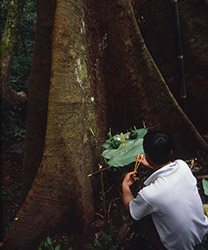
The Sacred Natural Sites Initiative regularly features “Conservation Experiences” of custodians, protected area managers, scientists and others. This post features the experiences of Professor Pei Shengi from the Kunming Institute of Botany and the Chinese Academy of Sciences. Prof. Pei has worked as an ethno biologist and ethnographer in the Yunnan province of southern China for several decades. His work on holy forests of the Dai is part of a broader body of work, which he has been leading into this area and has been broadly published. Besides an academic angle on the developments in the region he founded the The Centre for Biodiversity and Indigenous Knowledge, which also offers hands on help for consultation and development for biocultural conservation in rural areas. Read the full case study.
The holy hills presented this conservation experience are located at the Southside of the hills, part of the Yunnan Province and lie in the Xishuangbanna Dai Autonomous Prefecture, recognised as a UNESCO Man and Biosphere Reserve. Although it covers less than 0.2 per cent of the total land surface of China, it contains about 20 percent of the countries recorded species, which makes it the richest area for biodiversity in the country. It also hosts thirteen of Yunnan’s ethnic groups, mainly living in tropical and subtropical mainland areas. In recent years, reserves have been established to oppose the threats posed by economic and demographic growth.
The Dai are the most abundant ethnic group of the Prefecture believe that some sacred forests on Holy Hills (Nong) are the residence of the Gods. Plants and animals that inhabit these forests are their companions, along with the spirits of deceased ancestors who move to these forests after their death. Up till about 50 years ago, these forests were protected by traditional institutions led by a spiritual head man (Bimo) of the local village. Today the future of the forests is under threat from a range of changes in society including agricultural modernisation, market based production and shifts in local values and beliefs.
The story of the Holy hills is both beautiful and tragic but the last word on it has not been said, read the full case study to learn more: The Holy hills of the Dai: Autonomous Prefecture in Yunnan Province, China.







